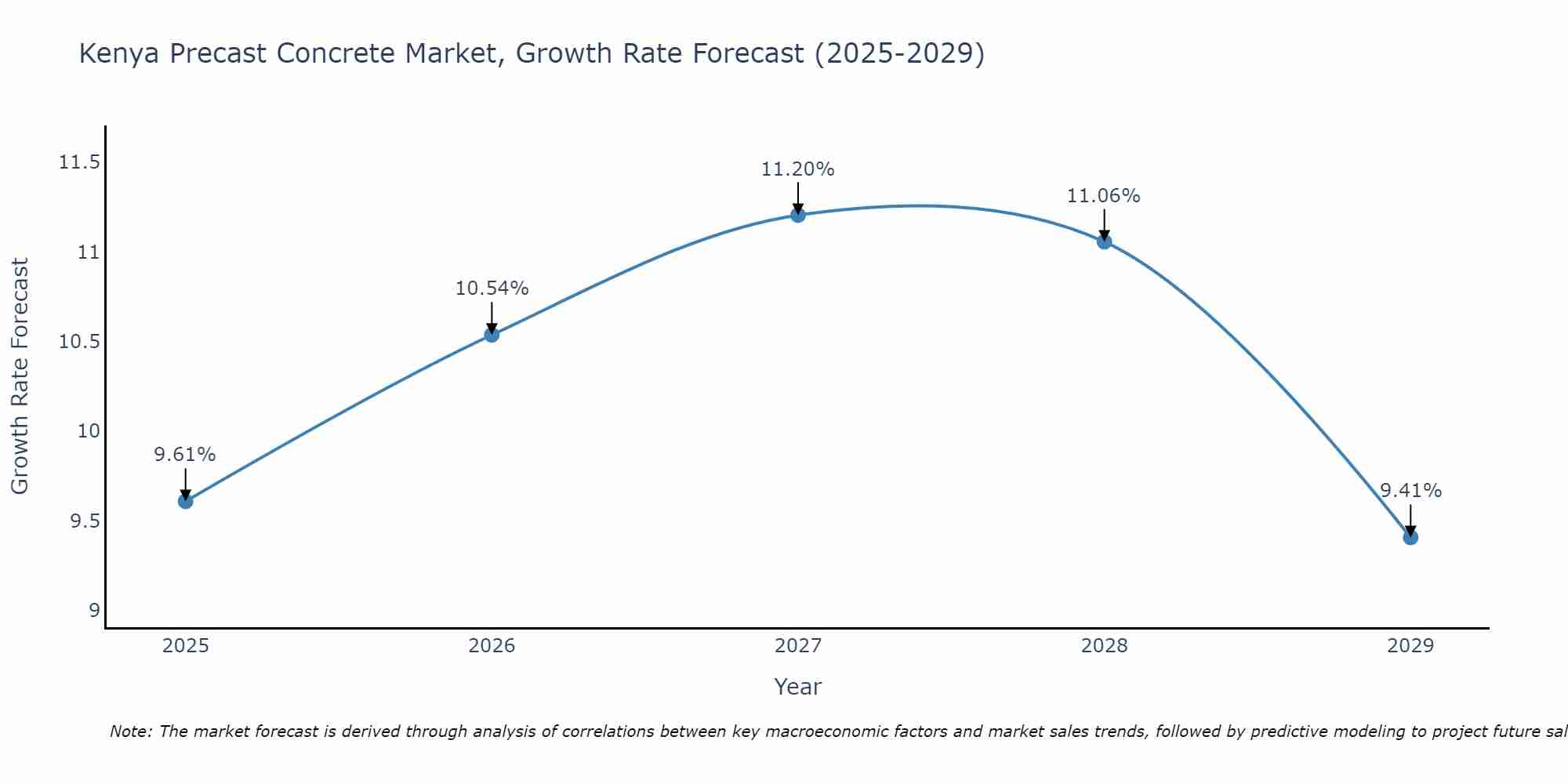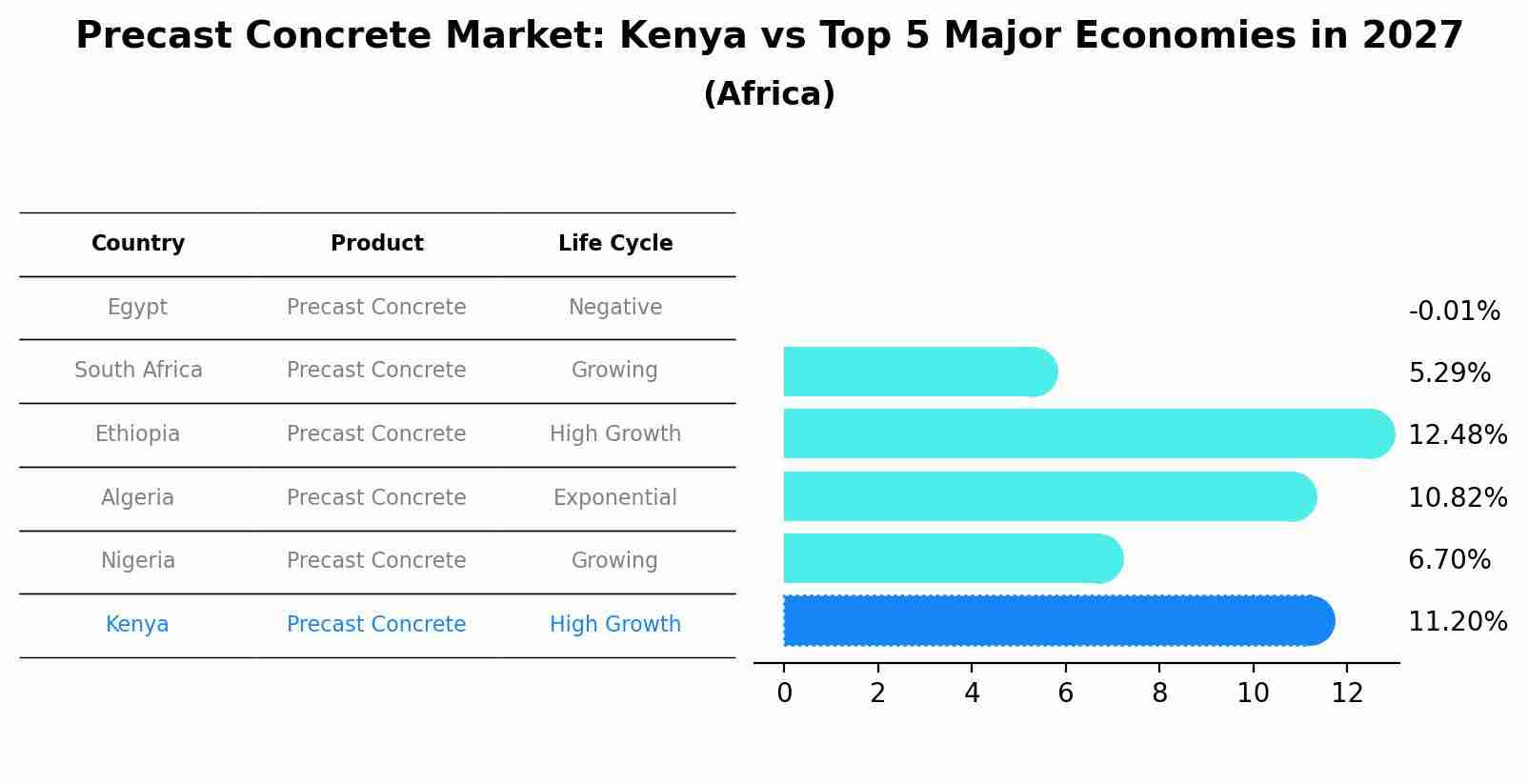Kenya Precast Concrete Market Outlook | Industry, Value, Size, Companies, Analysis, COVID-19 IMPACT, Revenue, Trends, Forecast, Share & Growth
| Product Code: ETC372890 | Publication Date: Aug 2022 | Updated Date: Jul 2025 | Product Type: Market Research Report | |
| Publisher: 6Wresearch | Author: Ravi Bhandari | No. of Pages: 75 | No. of Figures: 35 | No. of Tables: 20 |
Kenya Precast Concrete Market Size Growth Rate
The Kenya Precast Concrete Market is projected to witness mixed growth rate patterns during 2025 to 2029. The growth rate begins at 9.61% in 2025, climbs to a high of 11.20% in 2027, and moderates to 9.41% by 2029.

Precast Concrete Market: Kenya vs Top 5 Major Economies in 2027 (Africa)
By 2027, the Precast Concrete market in Kenya is anticipated to reach a growth rate of 11.20%, as part of an increasingly competitive Africa region, where Egypt remains at the forefront, supported by South Africa, Ethiopia, Algeria and Nigeria, driving innovations and market adoption across sectors.

Kenya Precast Concrete Market Synopsis
The Kenya precast concrete market is experiencing steady growth driven by increasing construction activities in the infrastructure, commercial, and residential sectors. The demand for precast concrete products such as panels, beams, slabs, and blocks is rising due to their cost-effectiveness, durability, and rapid installation benefits. Key factors fueling market growth include urbanization, population growth, government investments in infrastructure projects, and the adoption of modern construction techniques. Local precast concrete manufacturers are expanding their product portfolios and investing in advanced technologies to meet the growing demand. The market is characterized by intense competition, with players focusing on product innovation, quality assurance, and sustainable practices to gain a competitive edge. Overall, the Kenya precast concrete market is poised for further expansion, driven by the country`s ongoing development initiatives.
Kenya Precast Concrete Market Trends
The Kenya precast concrete market is experiencing significant growth driven by factors such as rapid urbanization, infrastructure development, and the increasing demand for affordable housing solutions. Key trends in the market include the adoption of advanced technologies for production processes, the rise of sustainable practices through the use of eco-friendly materials, and the development of innovative precast concrete products for various construction applications. Additionally, there is a growing emphasis on quality control and efficiency in manufacturing processes to meet the rising demand for precast concrete products in the Kenyan construction industry. Overall, the market is poised for continued expansion as stakeholders increasingly recognize the benefits of precast concrete in terms of cost-effectiveness, speed of construction, and durability.
Kenya Precast Concrete Market Challenges
In the Kenya precast concrete market, challenges primarily revolve around the high initial investment costs required for setting up precast concrete manufacturing facilities and acquiring specialized equipment. Additionally, there may be issues related to the availability of skilled labor for manufacturing and installing precast concrete products. Quality control and ensuring compliance with building standards and regulations are also significant challenges in the market. Limited awareness and adoption of precast concrete technology among architects, engineers, and construction professionals can pose a barrier to market growth. Furthermore, the industry may face logistical challenges in terms of transportation and delivery of precast concrete elements to construction sites, especially in remote or underdeveloped areas. Overcoming these challenges would require strategic partnerships, continuous innovation, and targeted marketing efforts to promote the benefits of precast concrete solutions in Kenya`s construction sector.
Kenya Precast Concrete Market Investment Opportunities
The Kenya precast concrete market presents promising investment opportunities due to the country`s growing infrastructure development and construction sector. With the government`s focus on enhancing transportation networks, housing projects, and commercial developments, the demand for precast concrete products such as beams, columns, slabs, and walls is on the rise. This market offers potential for investors to capitalize on the efficient production methods, cost savings, and quality control aspects of precast concrete manufacturing. Investing in precast concrete production facilities, innovative technologies for design and production, and strategic partnerships with construction companies can yield significant returns in the Kenyan market. Additionally, sustainable construction practices and the advantages of precast concrete in terms of durability and speed of construction further enhance the attractiveness of investing in this sector.
Jordan Agar Market Government Policies
The government of Kenya has implemented various policies to promote the growth of the precast concrete market in the country. These policies include the provision of incentives such as tax breaks and subsidies to encourage the use of precast concrete in construction projects. Additionally, the government has put in place regulations to ensure quality standards and safety measures are met in the production and use of precast concrete products. Furthermore, there are initiatives to promote research and development in the precast concrete industry to drive innovation and technological advancements. Overall, the government`s policies aim to stimulate the growth of the precast concrete market in Kenya by creating a supportive environment for businesses and promoting the adoption of precast concrete technology in the construction sector.
Kenya Precast Concrete Market Future Outlook
The future outlook for the Kenya Precast Concrete Market appears promising, driven by the country`s increasing infrastructure development projects, rapid urbanization, and growing demand for affordable housing solutions. Government initiatives to improve the construction industry and promote sustainable building practices are also expected to boost the market. Additionally, precast concrete offers advantages such as faster construction times, cost-effectiveness, and improved quality control, making it an attractive option for developers. As the construction sector continues to expand in Kenya, the precast concrete market is likely to witness sustained growth opportunities, with a focus on innovation, technology adoption, and eco-friendly practices shaping the industry`s future trajectory.
Key Highlights of the Report:
- Kenya Precast Concrete Market Outlook
- Market Size of Kenya Precast Concrete Market, 2021
- Forecast of Kenya Precast Concrete Market, 2031
- Historical Data and Forecast of Kenya Precast Concrete Revenues & Volume for the Period 2018 - 2031
- Kenya Precast Concrete Market Trend Evolution
- Kenya Precast Concrete Market Drivers and Challenges
- Kenya Precast Concrete Price Trends
- Kenya Precast Concrete Porter's Five Forces
- Kenya Precast Concrete Industry Life Cycle
- Historical Data and Forecast of Kenya Precast Concrete Market Revenues & Volume By Product for the Period 2018 - 2031
- Historical Data and Forecast of Kenya Precast Concrete Market Revenues & Volume By Structural Building Components for the Period 2018 - 2031
- Historical Data and Forecast of Kenya Precast Concrete Market Revenues & Volume By Architectural Building Components for the Period 2018 - 2031
- Historical Data and Forecast of Kenya Precast Concrete Market Revenues & Volume By Transportation Products for the Period 2018 - 2031
- Historical Data and Forecast of Kenya Precast Concrete Market Revenues & Volume By Water & Waste Handling Products for the Period 2018 - 2031
- Historical Data and Forecast of Kenya Precast Concrete Market Revenues & Volume By Others for the Period 2018 - 2031
- Historical Data and Forecast of Kenya Precast Concrete Market Revenues & Volume By End-use for the Period 2018 - 2031
- Historical Data and Forecast of Kenya Precast Concrete Market Revenues & Volume By Residential for the Period 2018 - 2031
- Historical Data and Forecast of Kenya Precast Concrete Market Revenues & Volume By Non-residential for the Period 2018 - 2031
- Historical Data and Forecast of Kenya Precast Concrete Market Revenues & Volume By Infrastructure for the Period 2018 - 2031
- Kenya Precast Concrete Import Export Trade Statistics
- Market Opportunity Assessment By Product
- Market Opportunity Assessment By End-use
- Kenya Precast Concrete Top Companies Market Share
- Kenya Precast Concrete Competitive Benchmarking By Technical and Operational Parameters
- Kenya Precast Concrete Company Profiles
- Kenya Precast Concrete Key Strategic Recommendations
Frequently Asked Questions About the Market Study (FAQs):
- Single User License$ 1,995
- Department License$ 2,400
- Site License$ 3,120
- Global License$ 3,795
Search
Related Reports
- Kenya Excavator, Crane, and Wheel Loaders Market (2025-2031) | Strategy, Consumer Insights, Analysis, Investment Trends, Opportunities, Growth, Size, Share, Industry, Revenue, Segments, Value, Segmentation, Supply, Forecast, Restraints, Outlook, Competition, Drivers, Trends, Demand, Pricing Analysis, Competitive, Strategic Insights, Companies, Challenges
- Angola Excavator, Crane, and Wheel Loaders Market (2025-2031) | Strategy, Consumer Insights, Analysis, Investment Trends, Opportunities, Growth, Size, Share, Industry, Revenue, Segments, Value, Segmentation, Supply, Forecast, Restraints, Outlook, Competition, Drivers, Trends, Demand, Pricing Analysis, Competitive, Strategic Insights, Companies, Challenges
- Israel Intelligent Transport System Market (2025-2031) | Strategy, Consumer Insights, Analysis, Investment Trends, Opportunities, Growth, Size, Share, Industry, Revenue, Segments, Value, Segmentation, Supply, Forecast, Restraints, Outlook, Competition, Drivers, Trends, Demand, Pricing Analysis, Competitive, Strategic Insights, Companies, Challenges
- Uganda Precast and Aggregate Market (2025-2031) | Strategy, Consumer Insights, Analysis, Investment Trends, Opportunities, Growth, Size, Share, Industry, Revenue, Segments, Value, Segmentation, Supply, Forecast, Restraints, Outlook, Competition, Drivers, Trends, Demand, Pricing Analysis, Competitive, Strategic Insights, Companies, Challenges
- Australia IT Asset Disposal Market (2025-2031) | Strategy, Consumer Insights, Analysis, Investment Trends, Opportunities, Growth, Size, Share, Industry, Revenue, Segments, Value, Segmentation, Supply, Forecast, Restraints, Outlook, Competition, Drivers, Trends, Demand, Pricing Analysis, Competitive, Strategic Insights, Companies, Challenges
- UAE Building Thermal Insulation Market Outlook (2025-2031) | Revenue, Companies, Share, Trends, Growth, Size, Forecast, Industry, Analysis & Value
- Portugal Electronic Document Management Market (2025-2031) | Strategy, Consumer Insights, Analysis, Investment Trends, Opportunities, Growth, Size, Share, Industry, Revenue, Segments, Value, Segmentation, Supply, Forecast, Restraints, Outlook, Competition, Drivers, Trends, Demand, Pricing Analysis, Competitive, Strategic Insights, Companies, Challenges
- France Electronic Document Management Market (2025-2031) | Strategy, Consumer Insights, Analysis, Investment Trends, Opportunities, Growth, Size, Share, Industry, Revenue, Segments, Value, Segmentation, Supply, Forecast, Restraints, Outlook, Competition, Drivers, Trends, Demand, Pricing Analysis, Competitive, Strategic Insights, Companies, Challenges
- Portugal Occupational Health & Safety Services Market (2025-2031) | Strategy, Consumer Insights, Analysis, Investment Trends, Opportunities, Growth, Size, Share, Industry, Revenue, Segments, Value, Segmentation, Supply, Forecast, Restraints, Outlook, Competition, Drivers, Trends, Demand, Pricing Analysis, Competitive, Strategic Insights, Companies, Challenges
- Netherlands Occupational Health and Safety Services Market (2025-2031) | Strategy, Consumer Insights, Analysis, Investment Trends, Opportunities, Growth, Size, Share, Industry, Revenue, Segments, Value, Segmentation, Supply, Forecast, Restraints, Outlook, Competition, Drivers, Trends, Demand, Pricing Analysis, Competitive, Strategic Insights, Companies, Challenges
Industry Events and Analyst Meet
Our Clients
Whitepaper
- Middle East & Africa Commercial Security Market Click here to view more.
- Middle East & Africa Fire Safety Systems & Equipment Market Click here to view more.
- GCC Drone Market Click here to view more.
- Middle East Lighting Fixture Market Click here to view more.
- GCC Physical & Perimeter Security Market Click here to view more.
6WResearch In News
- Doha a strategic location for EV manufacturing hub: IPA Qatar
- Demand for luxury TVs surging in the GCC, says Samsung
- Empowering Growth: The Thriving Journey of Bangladesh’s Cable Industry
- Demand for luxury TVs surging in the GCC, says Samsung
- Video call with a traditional healer? Once unthinkable, it’s now common in South Africa
- Intelligent Buildings To Smooth GCC’s Path To Net Zero













